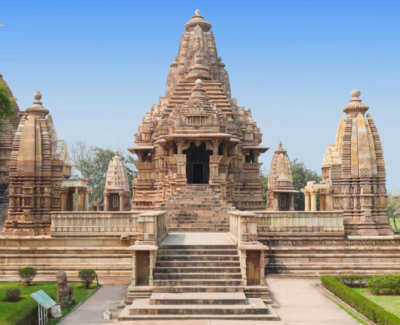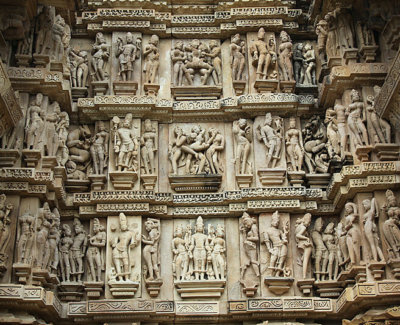Golden Triangle with Central India
Day 01: Arrive Delhi
You will arrive at New Delhi’s Airport. Following formalities and baggage collection, a Yatra Pundit representative will meet you as you EXIT the ARRIVALS TERMINAL building after which you would be transferred to your hotel.
India’s capital and a major gateway to the country, contemporary Delhi is a bustling metropolis, which successfully combines in its folds – the ancient with the modern. Amidst the fast spiralling skyscrapers, the remnants of a bygone time in the form of its many monuments stand as silent reminders to the region’s ancient legacy. The first impressions for any visitor traveling in from the airport are of a specious, garden city, tree-lined with several beautiful parks. Overnight stay at the hotel.
Day 02 : Delhi
After breakfast at the hotel, you will first visit Old Delhi. The tour will begin with a visit to Raj Ghat, a simple memorial to Mahatma Gandhi; Later drive to Red Fort for Photo stop from outside, visit Jama Masjid, one of Asia’s largest mosques and which is viewed from the outside. People stream in and out of the mosque continuously and the presence of a nearby bazaar means that the area is rarely quiet, In the afternoon, you will proceed for the tour to New Delhi which includes a drive past the imposing India Gate, the Parliament building and the Rastrapathi Bhawan and visit to the Qutub Minar, which is the tallest stone tower in India. The Qutub Minar was started in 1199 AD by Qutub-ud-Din Aibak and completed by the sultan’s successor and a son-in-law, Iltutmish. The Qutub Minar is still the highest stone tower as well as one of the finest Islamic structures ever raised in India. Overnight stay at the hotel.
Day 03: Delhi – Jaipur
After breakfast at the hotel, you will be driven to Jaipur (260 km / 05 hour) upon arrival, check in at the hotel. You will proceed to visit ancient capital of Amber to see the fabulous Amber Fort, Maharaja Mansingh, Mughal Emperor Akbar’s most successful General, started the construction of Amber Fort in the 17th century. Before the City Palace was constructed in Jaipur, Amber was the seat of power. The fort is surrounded by fortified battlements and overlooks the Moat Lake. Ruins and remains are spread over the Aravalli hills and sprawling crenulated walls lattice the surrounding area.
Elephant Ride at Amber Fort will spare you the trouble of reaching up to the fortress. Once on top, stroll through the sprawling complex of courtyards and halls, many of the rooms have delightful wall paintings, with precious stones and mirrors inlaid in the walls. Most fascinating, perhaps, is the Sheesh Mahal (hall of mirrors) where a single lamplight is reflected in the many mirrors, lighting up the room. Later, you will be transferred to hotel for check in.
Optional: Hot air Balloon Safari for about one hour, take a hot air balloon flight that will offer you breath-taking views of the countryside that will make you see Rajasthan from a completely new perspective. Balloon safaris happen either early in the morning or late in the evening because the weather is more stable then. Overnight stay at the hotel.
Day 04 : Jaipur
After breakfast at the hotel, you will visit the City Palace, which is an overwhelming complex of exquisite palaces, gardens and courtyards, decorative art and carved doorways. The palace museum houses collections of rare manuscripts, armoury, costumes, carpets and miniature paintings. Jaipur’s Jantar Mantar is the most famous of five observatories built by Sawai Jai Singh in India. Jai Singh was a great admirer of progresses and research made in the fields of science and technology, but he was passionate about astronomy. There is a very interesting story behind the construction of this observatory, considered as the largest stone observatory in the world. Sawai Jai Singh sent his emissaries to all parts of the world before commencing the construction of this observatory. The emissaries returned with many manuals on astronomy containing cutting-edge technological information. One of these manuals was a copy of La Hire’s “Tables”. The king ordered the observatory to be built according to the details contained in this manual. When the construction ended, for the astonishment of the king and others, the observatory was 20 seconds more accurate than the one mentioned in the table.
Evening Family dinner at Local family in Jaipur, where men can wear Indian traditional Kurta and women can wear saree, this will give you a very closest experience of Indian family and their living style. Overnight stay at the hotel.
Day 05 : Jaipur – Agra
After breakfast at the hotel, you will be driven to Agra (232 km / 4 hours), En-route visiting Fatehpur Sikri, the deserted red sandstone city, built by the Great Mughal Emperor Akbar as his capital and palace in the late 16th century, it was abandoned soon after it was built when the local wells went dry and it remains today in much the same condition that it was over 300 years ago. It is complete with palaces and mosques and used to be a town larger than London when it was originally constructed. Now it is an extraordinary place to wander around with its buildings in near perfect condition.
Upon arrival, check in at the hotel in the afternoon proceed to see Taj Mahal (closed on Fridays). Midway ”Battery operated Bus” would be waiting for you and will drop you at the gates of the Taj Mahal. The Taj Mahal is everything that has been said about it and more. Taking 22 years and 20,000 men to build, the white marble was quarried 200 miles away and was transported to the site by a fleet of 1000 elephants. Built by the Mughal Emperor Shah Jahan as an expression of his love for his wife Mumtaz Mahal, in mid 17th century, the Taj Mahal is truly one of the wonders of the world. Though the Taj appears to be amazingly perfect from almost any angle, it is the close-up marble inlay work, which is really astounding. You will have ample time to view and be mesmerized by this outstanding piece of architecture.
In the evening, you will visit to Agra Fort, an outstanding example of Mughal architecture, Agra Fort – the seat and the stronghold of the Mughal Empire under successive generations. This was the seat of Mughal rule and administration and the present structure owes its origins to Akbar who erected the walls and gates and the first buildings on the eastern banks of Yamuna River. Shah Jehan added the impressive quarters and the mosque while Aurangzeb added the outer ramparts. Visit its Hall of Public Audience and its Royal Pavilions. Overnight stay at the hotel.
Day 06 : Agra – Jhansi – Orchha – Khajuraho
After breakfast at the hotel, you will be transferred to railway station to board the train to Jhansi Upon arrival, proceed to visit Orchha.
Orchha was founded in the 15th century AD, by the Bundela chief, Rudra Pratap Singh, who became the first King of Orchha, (r. 1501-1531) and built the Fort of Orchha. On a seasonal island on the bank of the Betwa river, which has been surrounded by a battlement wall, stands a huge palace-fort. The fort consists of several connected buildings erected at different times, the most noteworthy of which are the Raja Mahal and the Jahangir Mahal. Later you will be driven to Khajuraho (172 km / 3 hoiurs). Overnight stay at the hotel.
Day 07 : Khajuraho
After breakfast at the hotel, explore the Western temples & Eastern temples of khajuraho while your guide explains the intricate meaning and legends behind each describable sculpture.
The legendary temples of khajuraho are an incomparable experience. Acknowledged as one of the world’s artistic wonders, these temples dedicated to the Hindu pantheon of Gods are covered in carvings that are a paean to life and love. Built within a short span of a hundred years by the Chandela Rajput, the 10th century temples lay forgotten until they were discovered in the present century. Khajuraho has achieved fame for the sensual appeal of its erotic sculptures. Overnight stay at the hotel.
Day 08 :Khajuraho – Varanasi
After breakfast at the hotel, you will be transferred to airport to board the flight to Varanasi Upon arrival, you will be transferred to the hotel for check in. In the afternoon, excursion to Buddhist town of Sarnath – The hallowed spot where Lord Buddha preached his first sermon after enlightenment. Evening boat cruise on the Ganges River at sunset to witness the grand evening aarti ceremony. Overnight stay at the hotel.
Day 09 :Varanasi
Today early morning boat ride on river Ganges to see sunrise. After breakfast at the hotel, you will see Bharat Mata Temple, Viswanathan Temple, and Bharat Kala Bhawan Museum etc. Overnight stay at the hotel.
Day 10 : Varanasi – Delhi
After breakfast at the hotel, you will be transferred to airport to board the flight to Delhi to board the onwards connection.





